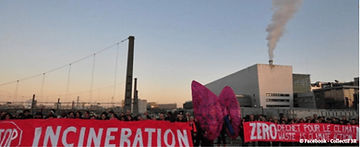
Media FR
Français
Incinérateur de déchets d’Ivry-Paris XIII : les émissions de dioxines n’ont pas été mesurées pendant près de 7000 heures en 2020 et en 2021
Un an après la révélation de concentrations records en dioxines à proximité de l’incinérateur d’Ivry-Paris XIII, notamment dans des œufs de poulaillers domestiques, l’Agence régionale de santé n’a toujours pas publié le rapport détaillé de l’étude qui l’a conduite à recommander l’arrêt de leur consommation dans toute l’Ile-de-France.
En parallèle, le Collectif 3R (réduire, réutiliser, recycler) a pu obtenir du SYCTOM1 les données détaillées issues des capteurs AMESA2 situés à l’intérieur des cheminées de l’incinérateur de déchets d’Ivry-Paris XIII et ainsi réaliser une étude complémentaire des mesures en semi-continu des émissions de dioxines avec la fondation néerlandaise ToxicoWatch.
A l’incinérateur d’Ivry-Paris XIII, les dioxines ne sont pas contrôlées « 24 h sur 24 et 365 jours par an »
Une étude révélée par « Le Monde » montre que les émissions de ces polluants très toxiques n’auraient pas été mesurées pendant près de sept mille heures entre 2020 et 2021.
Par Stéphane Mandard
Publié le 13 novembre 2023
Des niveaux élevés de dioxines, exceptionnellement élevés, autour de l'incinérateur Ivry-Paris XIII
Le Monde
February 7, 2022
Les analyses effectuées par la fondation ToxicoWatch autour du plus grand incinérateur d'Europe ont révélé des niveaux élevés de dioxines, souvent supérieurs aux normes sanitaires et parmi les plus élevés d'Europe.
The fumes of wrath: in a Paris suburb, the largest waste incinerator in Europe could be
poisoning locals
École de journalisme de Sciences Po / 19 avril 2022
The two chimneys of Ivry-sur-Seine’s waste incinerator have been releasing their white fumes into the sky of Paris for more than 50 years. Now, after a study uncovered “exceptionally high” levels of certain pollutants around the plan, locals wonder if the fumes have been poisoning them.
Des concentrations élevées de dioxines ont été détectées à proximité de l’incinérateur d’Ivry-Paris , qui traite des milliers de tonnes d’ordures ménagères par an.
8 février 2022 , Reporterre








